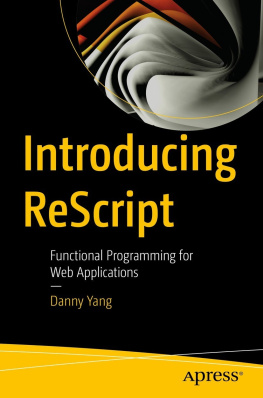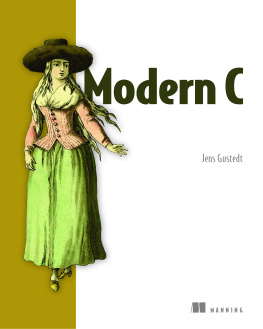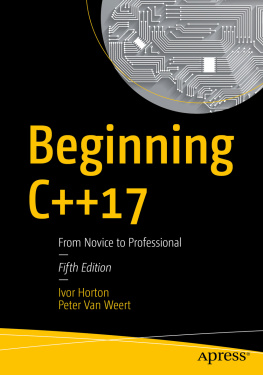For online information and ordering of this and other Manning books, please visit www.manning.com. The publisher offers discounts on this book when ordered in quantity.
Special Sales Department Manning Publications Co. 20 Baldwin Road PO Box 761 Shelter Island, NY 11964 Email:
2020 Jens Gustedt has released the manuscript of this work under a Creative Commons license for non-commercial use (CC BY NC). Jens Gustedt has granted to Manning Publications the exclusive commercial right to publish this work in print and electronic formats throughout the world.
No part of this publication may be reproduced, stored in a retrieval system, or transmitted, in any form or by means electronic, mechanical, photocopying, or otherwise, without prior written permission of the publisher.
Many of the designations used by manufacturers and sellers to distinguish their products are claimed as trademarks. Where those designations appear in the book, and Manning Publications was aware of a trademark claim, the designations have been printed in initial caps or all caps.
Acquisitions editor: Mike StephensDevelopment editor: Jennifer StoutTechnical development editor: Jon BergmanReview editor: Aleksander DragosavljevicTechnical proofreader: Nitin GodeCover designer: Marija Tudor
Acknowledgments
Special thanks go to the people that encouraged the writing of this book by providing me with constructive feedback, including
colleagues and other interested readers, Cdric Bastoul, Lucas Nussbaum, Vincent Loechner, Kliment Yanev, Szabolcs Nagy, Marcin Kowalczuk, Ali Asad Lotia, Richard Palme, Yann Barsamian, Fernando Oleo, Rbert Kohnyi, Jean-Michel Gorius ...
Mannings staff Jennifer Stout, Nitin Gode and Tiffany Taylor, ...
... and the impressive number of reviewers provided by Manning: Adam Kalisz, Andrei de Araujo Formiga, Christoph Schubert, Erick Nogueira do Nascimento, Ewelina Sowka, Glen Sirakavit, Hugo Durana, Jean-Franois Morin, Kent R. Spillner, Louis Aloia, Manu Raghavan Sareena, Nitin Gode, Rafael Aiquel, Sanchir Kartiev, and Xavier Barthel
Many others have contributed to the success of this book, my sincerest thanks to all of you.
About this book
The C programming language has been around for a long time the canonical reference for it is the book written by its creators, Kernighan and Ritchie []. Since then, C has been used in an incredible number of applications. Programs and systems written in C are all around us: in personal computers, phones, cameras, set-top boxes, refrigerators, cars, mainframes, satellites ... basically in any modern device that has a programmable interface.
In contrast to the ubiquitous presence of C programs and systems, good knowledge of and about C is much more scarce. Even experienced C programmers often appear to be stuck in some degree of self-inflicted ignorance about the modern evolution of the C language. A likely reason for this is that C is seen as an easy to learn language, allowing a programmer with little experience to quickly write or copy snippets of code that at least appear to do what its supposed to. In a way, C fails to motivate its users to climb to higher levels of knowledge.
This book is intended to change that general attitude, so it is organized in levels that reflect familiarity with the C language and programming in general. This structure may go against some habits of the books readers; in particular, it splits some difficult subjects (such as pointers) across levels in order to not swamp readers too early with the wrong information. Well explain the books organization in more detail shortly.
Generally, although many universally applicable ideas will be presented, that would also be valid for other programming languages (such as Java, Python, Ruby, C#, or C++) the book primarily addresses concepts and practices that are unique to C or are of particular value when programming in the C language.
C versions
As the title of this book suggests, todays C is not the same language as the one originally designed by its creators, Kernighan and Ritchie (usually referred to as K&R C). In particular, it has undergone an important standardization and extension process, now driven by ISO, the International Standards Organization. This led to the publication of a series of C standards in 1989, 1999, 2011, and 2018, commonly referred to as C89, C99, C11, and C17. The C standards committee puts a lot of effort into guaranteeing backward compatibility such that code written for earlier versions of the language, say C89, should compile to a semantically equivalent executable with a compiler that implements a newer version. Unfortunately, this backward compatibility has had the unwanted side effect of not motivating projects that could benefit greatly from the new features to update their code base.
In this book, we will mainly refer to C17, as defined in JTC1/SC22/WG14 [.
C and C++
Programming has become a very important cultural and economic activity, and C remains an important element in the programming world. As in all human activities, progress in C is driven by many factors: corporate or individual interest, politics, beauty, logic, luck, ignorance, selfishness, ego, sectarianism (add your primary motivation here). Thus the development of C has not been and cannot be ideal. It has flaws and artifacts that can only be understood with their historical and societal context.

![Jens Gustedt [Jens Gustedt] Modern C](/uploads/posts/book/146099/thumbs/jens-gustedt-jens-gustedt-modern-c.jpg)





![JD Isaacks [JD Isaacks] - Get Programming with JavaScript Next: New features of ECMAScript 2015, 2016, and beyond](/uploads/posts/book/121418/thumbs/jd-isaacks-jd-isaacks-get-programming-with.jpg)



 Recognizing the importance of preserving what has been written, it is Mannings policy to have the books we publish printed on acid-free paper, and we exert our best efforts to that end. Recognizing also our responsibility to conserve the resources of our planet, Manning books are printed on paper that is at least 15 percent recycled and processed without the use of elemental chlorine.
Recognizing the importance of preserving what has been written, it is Mannings policy to have the books we publish printed on acid-free paper, and we exert our best efforts to that end. Recognizing also our responsibility to conserve the resources of our planet, Manning books are printed on paper that is at least 15 percent recycled and processed without the use of elemental chlorine.